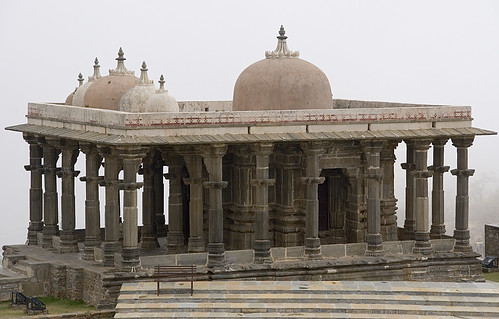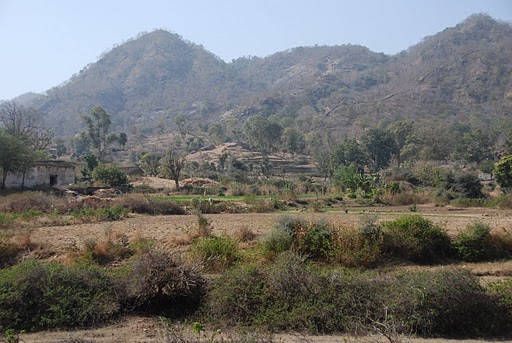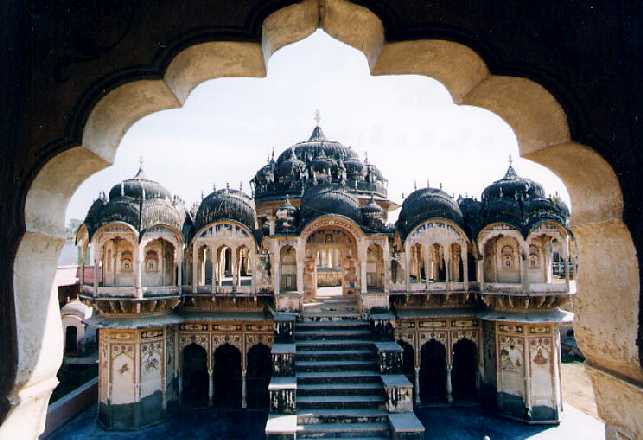Rajsamand is a small town in the state of Rajasthan. This city has been named after Rajsamand Lake, which is an artificial lake formed by Rana Raj Singh of Mewar in the 17th century. It is a very important place located at about 60 km from Udaipur and is the administrative centre of Rajsamand District, which is located in the watershed of the Banas River and its tributaries.Rajsamand is much rich district regarding history, religion, culture and mining industries. Among famous places of tourist interest Kumbhalgarh - the birth place of Maharana Pratap, Haldighati the famous battle field, Shrinathji the chief deity of Vaishnav religion, Dwarikadheesh, Charbhuja and many Shiv temples.Rajsamand is very well known for its marble production as the largest producing district as well as the largest single unit in the whole country. Rajsamand also saw the vicissitudes of the freedom struggle between TATYA TOPE and the British troops at 'Rakamgarh ka chhapar' in 1857.
How to reach here:
By Air: Being near to Udaipur, the nearest airport is the Udaipur airport.
By Rail: The closest railway station is located at Kankroli. This is connected to places such as Ajmer, Udaipur, Marvar, Malvi and a few other cities.
Places you must visit:
Kumbhalgarh fort is the birthplace of Maharana Pratap and second most important citadel of Mewar after Chittorgarh.The Aravali ranges protect this impregnable fortress. Thirteen mountain peaks surround it. It is built on the top most ridges, 914 meters above sea level. Seven huge and imposing gates stand like sentinels at the approaches and seven ramparts, one being folded within another with crenellated walls strengthened by rounded bastions and immense watch towers, make this an impregnable mountain fortress. It was built by Rana Kumbha (1419-63). It's serpentine 36 kilometres long wall is thick and broad enough for eight horses to ride abreast. This wall is second only to the 'Great Wall of China'. There are 360 temples within the fortress, out of which a Shiva temple placed with huge 'SHIVALINGA' makes it worth visiting.




Kumbhalgarh Wildlife Sanctuary is situated amidst the Aravali Range. The sanctuary surrounds the fort of Kumbhalgarh. It is spread in a total area of 608.57 sq km and is mainly known for its variety of endangered wildlife species and several medicinal herbs. It is also home to the Garasia and Bhil tribals.Apart from the herbs, the sanctuary comprises many other significant flora species like Dhok, Salar, Khair and Churel, while its main fauna species include leopards, sloth bears, hyenas, jackals, jungle cats, sambhar, nilgai, chaisingh, chinkara and hare. This wildlife park also has a wide variety of birds like peacocks, doves, grey pigeons, bulbul, grey jungle fowl, red spur owls, parakeets, golden orioles and white breasted kingfisher. Another attraction of this sanctuary includes the Ranakpur Jain Temples. Most of these temples were built in 1439. The most popular one amongst these is the Chaumukha Temple that comprises 29 halls supported by 1444 pillars. It is dedicated to Lord Adinath and neighbours two other Jain temples and a Surya temple.


Haldi Ghati is a narrow pass that runs South to North-East and ends in a plain where the famous battle of Haldighati was fought in 1576 between Maharana Pratap and the forces of Emperor Akbar.The colour of the soil here is yellow like turmeric (Haldi). Hence the valley is also known as Haldighati.Badshahibaug situated near the Haldighati is famous for 'CHAITRI-GULAB'. The rose water and 'Gulkand' (Rose Petal Jam) which has tremendous medicinal value and sweet taste as well.British author Col. James Todd described Haldighati as "Thermopile of Mewar" in his famous book 'Anals and Antiquities of Rajputana'.


West of Haldi Ghati, lies the tomb of Chetak. After being seriously wounded and loosing a leg in the fierce battle of Haldi Ghati, Chetak dutifully carried his master, Maharana Pratap, safely to this place and at last after crossing a stream, fell dead. Here stands a monument constructed and dedicated to the memory of this royal steed.Adjacent to the tomb, there is a temple of Lord Shiva. It appears that the Great Animal "Chetak" lies here in eternal sleep at the feet of his 'Lord Pashupatinath'.

The Rajsamand Lake is one of the most popular natural attractions of Rajsamand Town.Maharana Raj Singh an able administrator of the fifth generation of Maharana Pratap constructed Rajsamand lake in 1662 AD, which is a beautiful example of sculpture and public utility works. The banks known as "Nouchoki" consist of 25 carved stone -"RAJ PRASHASHTI" the longest stone inscription in Sanskrit in the world.The stairs, footrest, artistic gates and "Mandaps" are made of beautiful carved marble and the sculpture imparts a new look every time. The whole construction is based on the number 9 which is considered to be the absolute number in Hindu philosophy & mythology.It took 14 years for completion and cost more than 12.5 million rupees at that time.





Machind, situated in the Aravali range, parallel to the JARGA range of mountain is historically important.Maharana Pratap and his son Amar Singh stayed here for a short duration. The remnants of the construction of Pratap's age and a "Baori" (old well) are still visible.Guru Matsyendra Nath of Nath community prayed here in a cave, after whom the place is known as Machind.Machind is also known as the birthplace of Maharana Amar Singh.

Dewair is situated between the mountain ranges spread in close proximity of Kumbhalgarh and Madaria. In the olden times it had been under the domination of different tribes from Mer to Deora Rajputs.Maharana Pratap made the adventurous military campaigns of the Mughal ruler ineffective by resorting to gorilla warfare. On the auspicious occasion of Vijaya Dashmi, in 1852, he was crowned with historic victory, which led to the automatic liquidation of all 36 Moghul military outposts in Mewar. After this humiliating defeat Akbar stopped his military campaigns against Mewar.The victory of Dewair was a crowning glory for Maharana Pratap. Col. James Tod described Dewair as "Marathon of Mewar". In his famous book "Anals and Antiquities of Rajputana".A very beautiful victory Memorial on Marana Pratap was inaugurated by H.E. President of India, Smt. Pratibh Devi Singh Patil on 10.01.2012.




About 10 kilometres South-East of Rajsamand is the famous fort of Ramgarh, a small fortress built upon a small hillock, is said to be the silent evidence of the fight for freedom fought between Tantya Tope and the British troops in 1857, in the fields of Rakamgarh. It is also said that Tantya Tope stayed here in the Rakamgarh Fort for a short duration and was given all type of the help by the than ruler of Kotharia and the Tilkayat of Shrinathji.


Kankroli is one of the twin cities of Rajsamand District, mainly known for its Haveli of Sri Dwarkadhish Prabhu and the Kankroli Temple. The Kankroli Temple, also known as the 'Temple of Dwarikadheesh', is dedicated to Lord Krishna and is regarded as one of the most significant temples of the Vaishnavas and Vallabhacharya sect. This temple was built by Maharana Raj Singh in 1671 as a replica of the Nathdwara Shrine.The Haveli of Sri Dwarkadhish Prabhu in Kankroli is situated on the banks of Rajsamand Lake and is an important site for Pushti Margi Vallabhacharya Vaisnavs. Kankroli is also a commercial hub for being the home to a JK Tyre factory. The place is also famous for its marble mining activities. The famous Haldi Ghati and Chetak Tomb are also situated near this town.


Arsi Villas is an island situated on the west coast of Lake Pichola, behind the Jag Niwas. This Island is mainly famous for its palace, which was built by Maharana Arsi Singh for the purpose of enjoying the sunset at this lake. Another intriguing feature of this palace is that it has a lower platform at the back, which also serves as a helipad. This island also serves as a stop for many rare species of birds like kingfishers, tufted ducks, coots, egrets, terns and cormorants.

No comments:
Post a Comment